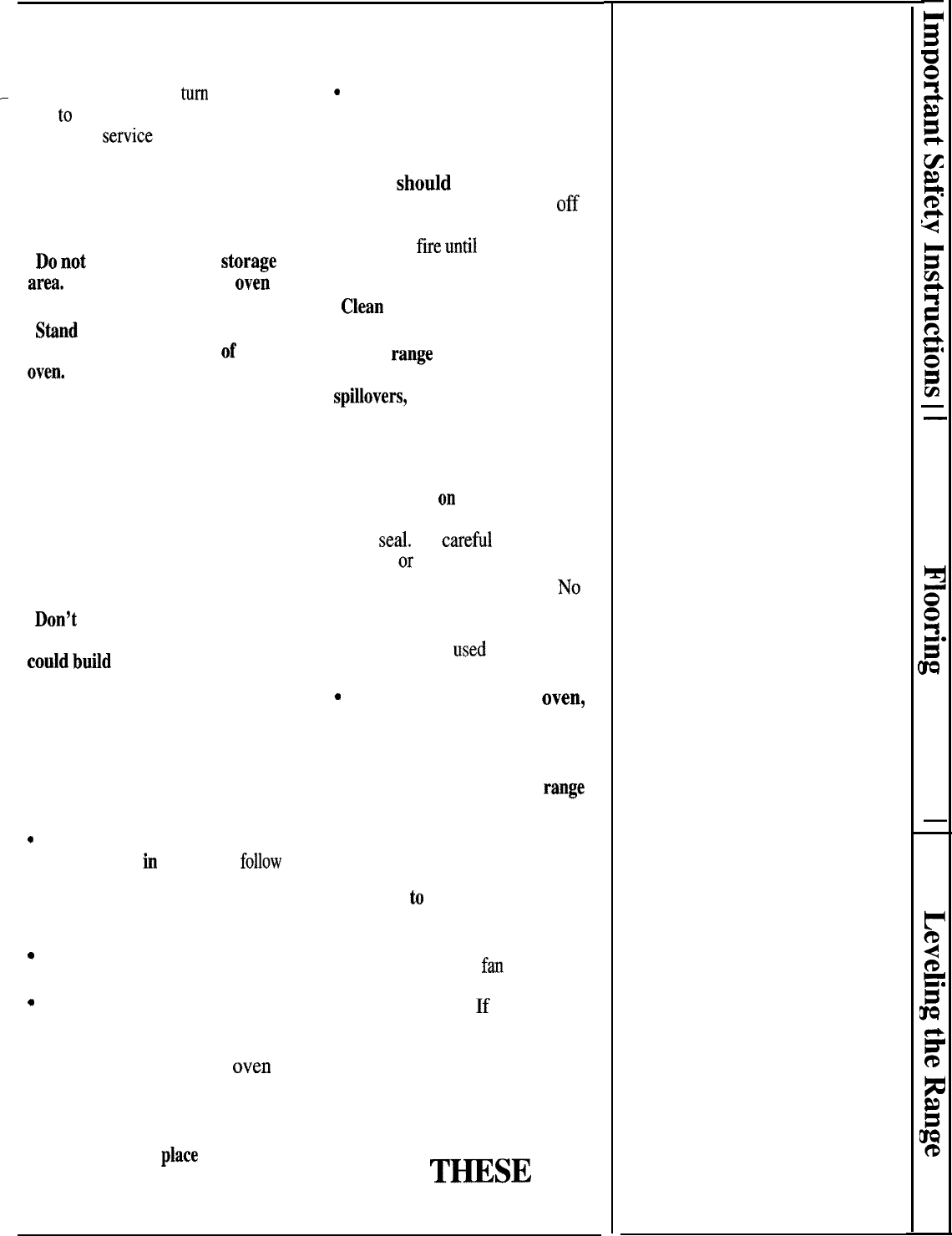
—
●
If you smell gas,
turn
off the
gas
to
the range and call a
qualified
service
technician.
Never use an open flame to
locate a leak.
Baking, Broiling and
Roasting
●
Do
not
use oven for a
storage
area.
Items stored in the
owm
can ignite.
●
Stand
away from the range
when opening the door
of
a hot
oven.
The hot air or steam that
escapes can cause burns to
hands, face and eyes.
●
Place oven shelves in desired
position while oven is cool.
●
Pulling out the shelf to the
shelf stop is a convenience in
lifting heavy foods. It is also a
precaution against burns from
touching hot surfaces of the
door or oven walls.
●
Don$t
heat unopened food
containers in the oven. Pressure
could
bui~d
up and the
container could burst causing
an injury.
●
Don% use aluminum foil
anywhere in the oven except as
described in this book.
Misuse
could result in afire hazard or
darnage to the range.
o
When using cooking or
roasting bags
in
the oven,
follow
the manufacturer’s directions.
●
Use only glass cookware that is
recommended
for use in gas ovens.
*
Keep the oven free from
grease buildup.
*
Always remove the broiler
pan from the oven as soon as
you finish broiling.
Grease left
in the pan cart catch fire if oven is
used without removing the grease
from the broiler pan.
—
●
Make
sure the broiler pan
and rack are in
piace
correctly
to reduce the possibility of a
grease fire.
@
When broiling, if meat is too
close to the flames, the fat may
ignite.
Trim excess fat to prevent
excessive flare-ups.
●
If you
shodd
have a grease
fire in the broiler pan,
turn
off
oven, and keep oven door closed
to contain
fire
until
it burns out.
Cleaning Your Range
●
Clean
only parts listed in this
Use and Care Book.
●
Keep
range
clean and free of
accumulations of grease or
spillovers,
which may ignite.
Self-Cleaning Oven
●
Do not clean the door gasket
before reading special cleaning
instructions
on
page 20.
The
door gasket is essential for a
good
sd.
Be
catwful
not to rub,
damage
or
move it.
●
Do not use oven
cleaners.
No
commercial oven cleaner or oven
liner protective coating of any
kind should be
used
in or around
any part of the oven,
o
Before self-cleaning the
oven?
remove broiler pan
and other
cookware.
●
Don’t attempt to repair or
replace any part of your
range
unless it is specifically
recommended in this book.
All
other servicing should be referred
to a qualified technician.
●
Be sure
to
wipe up excess
spillage before starting the
self-cleaning operation.
●
Listen for fan-a
fan
noise
should be heard sometime during
the cleaning cycle.
If
not, call for
service before self-cleaning again.
●
If
the self-cleaning mode
malfunctions, turn off and
disconnect power supply. Have
serviced by a qualified
technician.
SAVE
THESE
INSTRUCTIONS
Flooring Under
the Range
Your range, like so many other
household items, is heavy and
can settle into soft floor
coverings such as cushioned
vinyl or carpeting. When moving
the range on this type of flooring,
use care, and it is recommended
that these simple and inexpensive
instructions be followed.
The range should be installed on a
l/4-inch-thick sheet of plywood
(or similar material) as follows:
When the floor covering ends at
the front of the range, the area
that the range will rest on should
be built up with plywood to the
same level or higher than the floor
covering. This will allow the range
to be moved for cleaning or
servicing.
Leveling the Range
Use a 1%” open-end or adjustable
wrench to equally back out the
four legs. The flanges (rims) below
the sides of the maintop must be
raised above the top of the
countertop. Carefully slide the
range into its installation space.
Observe that it is clearing the
countertop. Then place a spirit
level or a glass measuring cup
partially filled with water on one
of the oven shelves to check for
levelness. If using a spirit level,
take two readings, with the level
placed diagonally first in one
direction and then the other.
Adjust the four legs carefully.
Level the range front to back and
side to side. The range legs must
rest on the floor. The range must
not hang from the countertop.
5


















